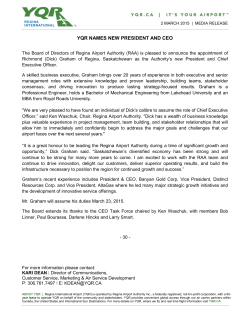
Document 360927
The Martha Graham Dance Company: Strategic Plan: FY 2013-‐17 Executive Summary Mission The Martha Graham Dance Company will continue to be a world leader in the evolving art form of modern dance, building on its legacy of innovation as it showcases classic American masterpieces alongside vital contemporary work, bringing the art form to a wider audience through performance and community activity. Introduction The Graham Company has examined the climate for dance companies based in New York and performing internationally, the characteristics of companies that have succeeded in that climate, and the ways in which the Graham Company meets or falls short of such models. Finally, an assessment of the Company’s strengths and weaknesses led the organization to identify four strategies that will assist in achieving the Company’s goals. Strengths and Weaknesses The Martha Graham Dance Company is an internationally recognized “brand” that connotes excellent repertory and performance, whether the Company is seen in the opera house settings in which it has historically appeared, or the alternative spaces it has been serving since 2006. Its Directors are respected as senior members of the dance field who fulfill artistic and financial commitments and respond to changing demands with flexibility. The Company now operates out of a newly acquired facility that is a tremendous improvement over the space it has used for the last twelve years. Its Board is engaged, meeting its obligation to participate at the oversight level and support the Company financially, both through gifts and (with a bit less success) solicitations. Nevertheless, it is true that the Board is smaller than appropriate for an organization with the Graham Company’s mission, and it lacks sufficient members with corporate experience. The Board is also in need of dynamic leadership as its senior members reduce their participation after decades of service. The staff is also smaller than it should be, with important gaps in development and other needs in finance and education. The Company must find ways to respond to a changing touring industry and increase its contributed income, which has historically hovered at 40% of the budget. Four Strategies for Fulfilling the Mission and Two Goals for the Future The Company has identified four strategies for immediate action and two additional strategies it plans to address as a second phase of its plan. Strategy I: The Company will commission new work and present the work of other companies in its studio theater. To date the Company has commissioned eight short works by recognized artists as a part of its Lamentation Variations project. It will seek relationships with funders and presenters to help support its plan to acquire existing works by dance masters and new works by prominent choreographers. It will plan its presentations on a calendar that rolls out five years at a time, and develop a mix of repertory that includes significant opera house works along with works best seen in more intimate settings. Strategy II: The Company will diversify its methods of booking its work internationally. Following the loss of its international agent, who passed away recently, the Executive Director will work more closely with local agents in various areas of the globe. This will require a greater allocation of the Director’s time for this project and, hence, additional staffing to support her other projects in development, finance, and education, prioritized in that order. Strategy III: The Company will undertake an archive project to enhance its service to the field. By the account of every archive, costume, set, and moving image expert who has viewed the Company’s collection, the Graham Company has the most complex and comprehensive archive in the modern dance world, and one of the most complex in all of the performing arts. The Company will acquire funding to preserve, organize and digitize the collection, and increase its earned income through appropriate licensing of archival materials. Strategy IV: The Company will earmark greater financial resources for its development effort. The Company must invest effort in developing its roster of Trustees and expanding its Board. The Board will increase its Nominating Committee membership and involve all members of the Board in the search for new members and leadership candidates. The Company will invest in its development department, hiring a specialist in institutional giving and increasing its individual specialist position to full time. The resulting development department will be: Executive Director, Director of Major Gifts and Special Events, Director of Institutional Gifts, Development Assistant, Assistant to the Executive Director. After the four primary strategies have been initiated, the Company will consider its educational and training programs, beginning with two identified strategies. Strategy V: The Company will develop a comprehensive department that embraces licensing, K-‐12 and university educational activities, and life-‐long learning programs for adults. Strategy VI: The Company will form partnerships with institutions of higher learning as an addition to its mission and as a means to expand its facilities. Conclusion The Company has already had notable success in accomplishing its goals and is pleased to announce a new association with IMG Artists to promote its international touring. The Board appointed three new members during the planning process and is committed to identifying four more members in the next year. The organization’s Director of Individual Development position was increased to fulltime in 2014 and a grant-‐writing consultant has been engaged to assist with institutional gift solicitation. The Board has formed the New Production Fund to energize support for commissions, and generous funding for the second and third years of the archive project has been received. Thoughtful planning and consistent implementation have been the key to these achievements.
© Copyright 2025





















